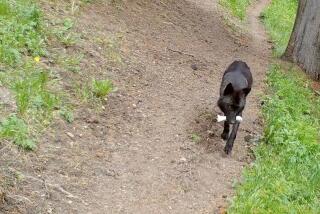Crucial Roles of Older Female Animals
- Share via
It never occurred to me that my empty nest wouldn’t be entirely empty. Sure, the kids grew tall, filled out, packed their bags and left. They are in the prime of their biological lives. But the sweet cat who joined our family as a kitten when the children were toddlers remains behind. Unlike her departed masters, at 18 Mildred is old. Along with other parents of college students, I find myself living with and contemplating a geriatric pet.
Of course Mildred is a domesticated animal. Orphaned at 2 weeks, she was nursed on a medicine dropper and then applauded at her first efforts at independence. Today, a veteran of coyote and German shepherd assaults, she is again being catered to. She dines on soft foods now because she has difficulty digesting the coarser stuff. I’ve often pondered if she could survive on her own. Feral cats do manage in city streets, but those her age most likely starve in their competition for sparse resources.
Yet Mildred is wise. She might, in fact, do well out there on her own. Thin and bony despite the great quantities she consumes, she has learned to upset the kitchen garbage in order to extract those bones we judged unfit for her to eat. Moreover, she knows the terrain of all the neighbors’ houses and garages, which she regularly invades. Were she a member of a pack of wild cats, they would do well to keep her with them. She is a survivor.
Until recently there was a zoological myth that in nature older females of the species were useless, and so abandoned after their reproductive years (if in fact they lived beyond those years). Anthropologists such as the late Margaret Mead even asserted that the human species is unique in retaining post-menopausal females in their midsts as shamans or historians of the tribe. And so she explained the origins of civilization.
She was wrong. Social groups of species as diverse as lions, ground squirrels, elephants and whales include and often depend upon old females that have not produced offspring for some time. Post-reproductive females play crucial roles in the lives of many species.
Look at the lions. I often do when I visit zoos, and of course I think of them as Mildred’s relatives. Observers in Africa have noted ancient lionesses with worn-down or missing teeth that are able to survive as part of the pride for as long as an estimated 20 years because they are cared for by younger lionesses who do their hunting for them. No longer either hunting or bearing young, these lionesses play with the cubs and form an integral part of the pride.
Unlike human beings, other mammals do not experience a physiological change akin to menopause, at least not one that zoologists have been able to observe. And unlike humans, older female elephants and pilot whales continue producing milk and feeding other animals for as long as a decade after their last birth. Elderly elephants have been found dead with milk in their teats and, at their deaths, the other elephants, in what is largely a female social group, have been seen milling around the dead individual and then burying her corpse under piles of brush. There is clearly something going on among them that we have not understood, but which indicates that these elderly females are crucial to their communities.
Reports on pilot whales reveal that lactating but no longer reproductive females make up as much as a quarter of any “pod.” Corpses of whales as old as 17 that have been caught in fishermen’s nets reveal stomachs full of milk. While these adult animals had long survived on other foods, the milk suggests that they had continued suckling for some other reason. Female whales seem to maintain bonds with their own offspring, and perhaps with others in their pod, by providing the security of their nipples.
Among much shorter-lived species, the older females among the Belding’s ground squirrels in the valley near Yosemite act as sentry. They sound alarm chirps when they see predators approach, warning the younger mothers with babies. They stand up to call, exposing themselves to danger. Observers have recorded that these alarm-callers provide a disproportionate amount of the predator’s prey.
Our human society is not so different from those of these other species. Where we diverge most notably is that among humans, males as well as females live beyond their prime. As for Mildred, spayed in kittenhood, she never reproduced as she might have in the wild. But like her cousin the lioness, she is a valued companion and part of our pride.
More to Read
Sign up for Essential California
The most important California stories and recommendations in your inbox every morning.
You may occasionally receive promotional content from the Los Angeles Times.









